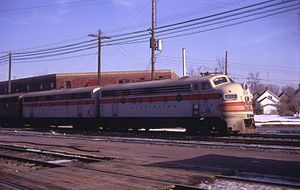EMD F7

Chicago, Burlington and Quincy Railroad F7 A and B-units in Galesburg, Illinois in 1968.
|
|||||||||||||||||||||||||||||||||||||||||
|
|||||||||||||||||||||||||||||||||||||||||
|
|||||||||||||||||||||||||||||||||||||||||
|
|||||||||||||||||||||||||||||||||||||||||
|
|||||||||||||||||||||||||||||||||||||||||
| Type and origin | |
|---|---|
| Power type | Diesel-electric |
| Builder |
General Motors Electro-Motive Division (EMD) General Motors Diesel (GMD, Canada) |
| Model | F7 |
| Build date | February 1949 – December 1953 |
| Total produced | 2,366 A units, 1,483 B units |
| Specifications | |
|---|---|
| AAR wheel arr. | B-B |
| Gauge | 4 ft 8 1⁄2 in (1,435 mm) |
| Trucks | Blomberg B |
| Wheel diameter | 40 in (1,016 mm) |
| Minimum curve | 23° (250.79 ft or 76.44 m radius) |
| Wheelbase | 39 ft (11.89 m) |
| Length | A unit: 50 ft 8 in (15.44 m) B unit: 50 ft 0 in (15.24 m) |
| Width | 10 ft 7 in (3.23 m) |
| Height | 15 ft (4.57 m) |
| Loco weight | 247,300 lb (112,200 kg) |
| Prime mover | EMD 16-567B |
| RPM range | 800 |
| Engine type | Two-stroke V16 diesel |
| Aspiration | Roots-type supercharger |
| Displacement | 9,072 cu in (148.66 L) |
| Generator | EMD D-12 |
| Traction motors | (4) EMD D-27-B |
| Cylinders | 16 |
| Cylinder size | 8 1⁄2 in × 10 in (216 mm × 254 mm) |
| Performance figures | |
|---|---|
| Power output | 1,500 hp (1,100 kW) |
| Career | |
|---|---|
| Locale | North America |
The EMD F7 was a 1,500 horsepower (1,100 kW) Diesel-electric locomotive produced between February 1949 and December 1953 by the Electro-Motive Division of General Motors (EMD) and General Motors Diesel (GMD).
Although originally promoted by EMD as a freight-hauling unit, the F7 was also used in passenger service hauling such trains as the Santa Fe Railway's Super Chief and El Capitan.
The F7 was the fourth model in GM-EMD's successful line of F unit locomotives, and by far the best-selling cab unit of all time. In fact, more F7's were built than all other F units combined. It succeeded the F3 model in GM-EMD's F unit sequence, and was replaced in turn by the F9. Final assembly was at GM-EMD's La Grange, Illinois, plant or GMD's London, Ontario, facility.
The F7 differed from the F3 primarily in internal equipment (mostly electrical) and some external features. Its continuous tractive effort rating was 20% higher (e.g. 40,000 lb (18,000 kg) for an F7 with 65 mph (105 km/h) gearing, compared to 32,500 lb (14,700 kg) for an F3 with the same gearing.
A total of 2,366 cab-equipped lead A units and 1,483 cabless-booster or B units were built. (Note: the B unit is often referred to as an "F7B", whereas the A unit is simply an "F7".)
Many F7s remained in service for decades, as railroads found them economical to operate and maintain. However, the locomotive was not very popular with yard crews who operated them in switching service because they were difficult to mount and dismount, and it was also nearly impossible for the engineer to see hand signals from a ground crew without leaning way outside the window. As most of these engines were bought and operated before two-way radio became standard on most American railroads, this was a major point of contention. In later years, with the advent of the "road switchers" such as the EMD GP7, F units were primarily used in "through freight" and "unit train" service where there was very little or no switching to be done on line of road.
...
Wikipedia
